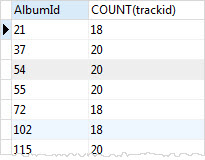
At a high level, the process of aggregating data can be described as applying a function to a number of rows to create a smaller subset of rows.

When we apply a grouping operation to a dataset in SQL, we split the dataset into distinct “groups.” In practice, the type of function most commonly applied to a group of data is an aggregation function. This post is structured so that you can skip around based on your current knowledge already comfortable with grouping operations in SQL? Jump directly to the Python section, and vice versa. To see how all the examples mentioned in this post are implemented in practice, check out this example report. groupby() function and a GroupBy in SQL is performed using an SQL GROUP BY statement. A GroupBy in Python is performed using the pandas library. Today, we'll focus on GroupBy operations, which are another great example of a task that can be executed by both SQL and Python, and for which the decision of language depends on your goals.Ī GroupBy in Python and SQL is used to separate identical data into groups to allow for further aggregation and analysis. We’ve written previously about the differences in how Python and SQL execute window functions. Only by learning about the functional overlap of analytical languages can we make these decisions effectively. On the other hand, Python enables many complex functions that are not feasible in SQL, and the value of a SQL-only approach might be outweighed by the wider array of operations that are made available when using both languages together.
Sqlite count group by example code#
But if the benefit of concision is outweighed by the value of having all analytical code exist in a single language, you'll still want to use SQL.
Sqlite count group by example how to#
And with a deep understanding of both, we can all make smarter decisions about how to combine and leverage each, making it easy to always choose the right tool for every task.įor instance many functions are more concisely written in Python. But there are actually many overlapping functions that can be accomplished by both SQL and Python.Įxploring the overlapping functionality of SQL and Python can help those of us familiar with one language become more adept with the other. The prevailing dialogue around this kind of multi-lingual approach, especially with SQL and Python, typically portrays the languages as complementary, yet functionally discrete. You can use the OVER clause with functions to compute aggregated values such as moving averages, cumulative aggregates, running totals, or a top N per group results.Analysts and data scientists with a deep understanding of multiple analytical programming languages find themselves at an advantage in today’s data landscape. A window function then computes a value for each row in the window. The OVER clause defines a window or user-specified set of rows within a query result set. PARTITION BY does not affect the number of rows returned, but it changes how a window function's result is calculated. On the other hand, GROUP BY gives one row per group in result set.Ī GROUP BY normally reduces the number of rows returned by rolling them up and calculating averages or sums for each row. If we have 15 records in the table, the query output SQL PARTITION BY also gets 15 rows.

PARTITION BY gives aggregated columns with each record in the specified table. You can use the SQL PARTITION BY clause with the OVER clause to specify the column on which we need to perform aggregation.


 0 kommentar(er)
0 kommentar(er)
